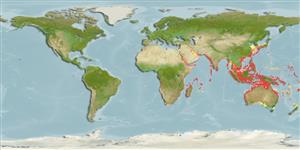Preferred temperature (Ref.
115969): 22.8 - 29, mean 28 (based on 1324 cells).
Phylogenetic diversity index (Ref.
82804): PD
50 = 0.5000 [Uniqueness, from 0.5 = low to 2.0 = high].
Bayesian length-weight: a=0.00661 (0.00584 - 0.00747), b=3.00 (2.97 - 3.03), in cm Total Length, based on LWR estimates for this species (Ref.
93245).
Nivel trófico (Ref.
69278): 4.5 ±0.4 se; based on diet studies.
Resiliencia (Ref.
120179): Medio, población duplicada en un tiempo mínimo de 1.4-4.4 años (K=0.12-0.21; tm=2-3; tmax=14; Fec=590,000).
Prior r = 0.98, 95% CL = 0.65 - 1.47, Based on 1 full stock assessment.
Fishing Vulnerability (Ref.
59153): Moderate to high vulnerability (52 of 100).
Climate Vulnerability (Ref.
125649): High to very high vulnerability (75 of 100).
